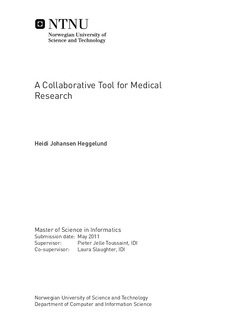A Collaborative Tool for Medical Research
Master thesis
Permanent lenke
http://hdl.handle.net/11250/252432Utgivelsesdato
2011Metadata
Vis full innførselSamlinger
Sammendrag
Medical researchers today often work in a highly collaborative environment. The methods used to collaborate often include face to face meetings, unnecessary e-mail discussions, and huge amounts of documents sent and received in order to cooperate, share and contribute to each others work. The collaboration gets even more challenging as researchers today often do not work from the same location. For this study, the purpose has been to explore if there are ways in which the everyday work of dementia researchers can be supported and made more efficient by the use of web-based collaborative tools. A case study including four researchers related to dementia research has been conducted. A series of interviews with the researchers were done, and based on the findings from these, a prototype has been suggested and evaluated by the participants. The main findings shows that there is a need for further support during collaborative and coordinating activities in order to make the research process more effective. A web-based collaborative tool made with the medicine 2.0 approach in mind is suggested, which includes social networking, supporting collaboration between different actors, and openness and sharing between these actors. The main finding from this study is that there is a need for improved methods to support the collaboration and coordination between dementia researchers. Allowing the researchers to create social networks including sharing and collaboration related to files was seen as effective. It had potential of reducing the time spent revising documents as a result of tagging and notification functionality, in addition to improve coordination between colleagues because the awareness of what other project members were doing increased. The study also shows that there is a potential in using patient-produces sources such as blogs and illness communities in research, specially within qualitative research and social welfare studies. A need to improve the visualization of available data during the examination phase was discovered, however the need was not so strong as for improving collaborative activities.
